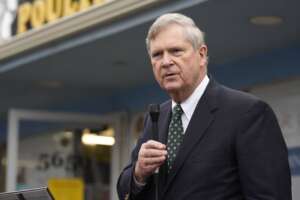USDA joins SSA in telling employees about reentry plans
Shalanda Young, the nominee to be the director of OMB, told Senate lawmakers that agencies are on track to bring employees back to the office by March.
Employees at the Agriculture Department have a timetable for when some will be expected to return to the office.
USDA Secretary Tom Vilsack and Deputy Secretary Jewel Bronaugh sent an email to employees yesterday outlining dates and plans between now and May.
“While we continue to monitor the status of the pandemic, it is our intent to also continue our phased return to the physical workspace,” the email, which Federal News Network obtained, told employees.
The current plan would stagger how employees return to the office.

(AP Photo/David Zalubowski)
By Feb. 28, USDA expects senior leadership, including political appointees, Senior Executive Service members, senior level, scientific and professional, senior scientific and technological service and senior foreign service officers to return to the office.
Then by March 28, “Agencies and staff offices will begin their phased return to the physical workplace plans to welcome back employees who do not have remote work agreements, subject to completion of labor negotiations.”
Prior to that deadline, employees, by Feb. 11, will receive notice from the agency about their remote work or telework status, and their 45-day notification to return to the office. This is, of course, dependent on negotiations with the unions that represent USDA employees, the email stated.
Vilsack and Bronaugh’s email said by May 27, agencies and staff offices will fully implement these return to the office plans.
“At USDA, we are in close coordination with the Safer Federal Workforce Task Force to ensure that safety protocols are regularly updated and followed,” the email stated. “We are also exceedingly grateful to the thousands of you who have continued to work on the front lines and in-person since the start of this pandemic. Your service to this department and the American people is considerable.”
‘Appears reasonable right now’
Emails to USDA seeking additional comments or information about the return to work planning weren’t returned.
The National Federation of Federal Employees (NFFE-IAM), which represents employees in the Forest Service and other USDA agencies, supported the department’s planning timeline.
“NFFE-IAM supports USDA employees who do not want to return to the workplace in person until it is safe to do so. While the projection of March 28 appears reasonable right now, we have learned that the COVID pandemic is unpredictable in its development of variants and breakthrough cases,” said Randy Erwin, NFFE-IAM national president in an email to Federal News Network. “As a result, we have had return to work dates in place that have been pushed back. NFFE-IAM will be working with our members and providing input to USDA as we monitor the situation moving forward.”
The American Federation of Government Employees (AFGE), which represents about 100,000 USDA employees, said only the Social Security Administration has completed negotiations about returning employees to the office.
AFGE and SSA reached an agreement on Jan. 19 that detailed the agency’s plans for employee reentry and implementation of new telework schedules for most employees on March 30.
It’s unclear how the omicron variant of COVID-19 has impacted agencies return to the office plans. In December, several agencies were moving forward with their plans.
Tracking reentry into March
Shalanda Young, the nominee to be the director of the Office of Management and Budget, told the Senate Homeland Security and Governmental Affairs Committee today that the omicron variant definitely forced agencies to go back to the drawing board for how to bring employees back to the office safely.
“We do have agencies, and I’m one of them, trying to bring people back into the office. We have people who work in SCIFs so we have to make sure they are safe when they come into the office. The Homeland Security Department has border patrol agents who’ve never not been on the job. So each agency has to do what’s right for their particular employees,” Young said. “My takeaway is this is difficult. This is a one in a generation event and there is no playbook. But I think we have been able to keep up variant specific situations and what we are seeing is agencies are on track, if they haven’t already, bring people in over the next months into March.”
In June, OMB required agencies by the following month to develop plans to have employees return to the office. Agencies began setting tentative reentry dates until omicron threw a wrench into those plans.
Over the past two years, USDA has been trying to bring employees back to the office. In June 2020, USDA moved into phase one of reentry plans around the National Capital Region with about 400 employees returning to the office. It had planned to bring back an additional 700 employees later during summer of 2020 and had a phase 3 planned for later in the year.
By March 2021 with the emergence of the delta variant and the transition to the Biden administration, USDA began to rethink its expectations of the workforce. Vilsack launched a new initiative to determine how best to implement broader telework and permanent virtual options.
Lawmakers continue to press OMB on when employees will return to the office.
House Minority Leader Kevin McCarthy wrote to OMB, the Office of Personnel Management and the General Services Administration in December expressing concerns about the continued maximum telework of agencies.
In November, a group of Senate Republicans joined in the calls for federal employees to return to their offices. Sen. Cynthia Lummis (R-Wyo.) is the lead sponsor of the Having Employees Return to Duty (HERD) Act. The bill requires federal employees resume their pre-pandemic telework and working schedules. It applies to all federal employees except those at the Defense Department. Employees would have to return to the office within 60 days of the bill’s passage. Lummis says she hears complaints from constituents struggling to access in-person service from the Social Security Administration and other agencies.
The HERD Act hasn’t advanced since it was introduced.
Copyright © 2025 Federal News Network. All rights reserved. This website is not intended for users located within the European Economic Area.
Jason Miller is executive editor of Federal News Network and directs news coverage on the people, policy and programs of the federal government.
Follow @jmillerWFED






